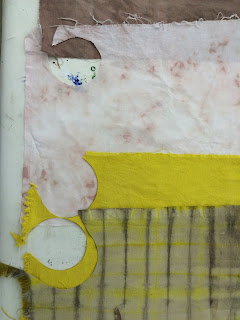My Notes:
- Textiles reveal the human compulsion to engage with texture, color and storytelling.
- Cultural significance - through the ages so many produced and so many survived (remarkable since so fragile).
- Large amounts of the very earliest textile exist today because they were buried as grave goods.
- Important role textiles have always played in ritual.
- Represent wealth and power, given as gifts, used to pay taxes, exchange for other good or services, even for peace.
- The divine right to rule ensured that the kings and caliphs overflowed with exquisite textiles.
- Homes of wealthy impressive textile legacies
- Among many culture, textiles passed along lines of descent - dowry, lineage of woman.
- Long before museums, collectors preserved textiles.
- 17th century - more prestigious and to own a fine silk garment or tapestry than a painting.
- Industrialization, gentrification, 20th century modern art movement pushed textiles to less important. Financial investment in painting and sculpture took precedence.
- Link to gender - men hold power for wealth and money and opportunity - textiles reduced to women's work. (Before industry, living more communal within a family and village)
- Return to importance - 1960's - founded International Tapestry Biennial Switzerland and breakdown of tradition distinctions between art forms - allowed for wider/non-traditional use of materials. Installation art.
- 1970's - Shift - instead of art that can only go into museums, art being made that couldn't go into museums. Earthworks. Christo and Jean Claude.
- Also 1970's - feminist artists - confronting subjugation of women - incorporate textiles.
- Principles of collage in early textiles - appliqué and patchwork.
- Buddhist banners made of scraps of silk - chogak po a Korean patchwork method.
- Textile metaphors - following the thread, spinning the yarn - language, interwoven.
- Ilka White, Entaglement, "Thinking about…all the myriad forms of connection, subtle to vast. Like when your chest feels ripped apart by the sky's eloquence. The mind extends way out beyond the skull…As the quantum physicist tells us, we live in an entangled universe."
- Development of human brain stimulated by the emergence of basket weaving techniques.
- Making of textiles - cognitive processing - led to robotics and computing.
- Evidence - genetic - those that think with their fingers and are destined to manipulate materials.
- Visual vocabulary of textiles - thousands of years - connect cultures.
- Egypt - roundel form.
- Persia 224-642 - silk, first know examples of pictorial loom-woven lengths of cloth, different colored wefts. Dispersed as gifts and traded goods along the Silk Road (up to Scandinavia).
- Tang dynasty - roundel aligned with Buddhist whee/cycle of life symbol - iconic image of court and church in China, Japan, India.
- Roundel modified by silk weavers into curved ogee typical of Italian Renaissance patterns (influenced by Islam, caliphs banned depiction of ??? from some regions).
- Design endures, distinct, sign of continuity and survival.
- Encircled eagle, emblem of Holy Roman Empire becomes Great Seal of the United States.
- Origin inherent with textiles - material originating from plants/animals, someone makes the yarn/fiber. Origin, before, history, past - (link to the metaphors of following a thread and spinning a tale. All the different hands and places the materials passes)
- Slavery. Also pesticides, bleaching.
- Natural world managed and altered to suit human need - (this need rooted in sensual desire - our desire to see or be seen with certain colors, textures, objects.
- Peruvian textiles began to be excavated by German archaeologist in the 1880's.
- Bauhaus - two cornerstones of modernism - the foundation course (the first to define methods of coordinating color according to hue's contrast properties, including intensity.
- Itten - interest in weaving - learns from Gunta Stolz - Gunta becomes master of the weaving workshop in 1927.
- Esther Fitzgerald - Modernism ws nourished by elements form the common pool of mystical ideas.
- Suggests Asian textiles direct influence on Modernist color theory.
- Anni Albers illustrated cloths by Peruvian weavers and cited them as her great teachers.
- Agnes Myrtle Nelson - Analysis of Peruvian Weaves
- Sensual and intensely reflective
- Brennan-Wood - Vase Attacks San Francisco - reveals darker influences.
- Roxanne Hawksley - Surgeon's Equipment
- "Textiles form a firm foundation, a network linking a regard for the past, questions about the present and exhilarating ideas of the future."
Pile carpets, once rare, most extravagant of objects for the interior.
These carpets for historians signify the presence of a highly organized workshop.
Warp-looped piled clothes introduced to West via Italy beginning of 13th century, known as velvet, from Latin villus , meaning "laggy hair.






















































